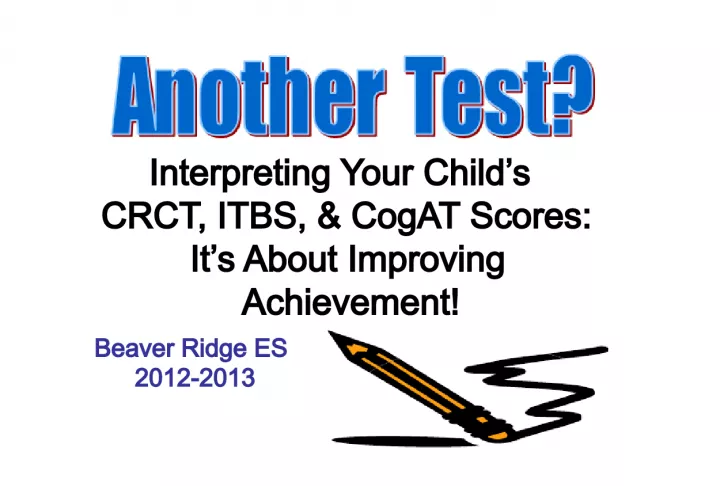Interpreting Your Child's CRCT, ITBS, & CogAT Scores: It's About Improving Achievement


This article discusses the major tests given at Beaver Ridge Elementary School during the 2012-2013 school
- Uploaded on | 5 Views
-
 amadeusharlem
amadeusharlem
About Interpreting Your Child's CRCT, ITBS, & CogAT Scores: It's About Improving Achievement
PowerPoint presentation about 'Interpreting Your Child's CRCT, ITBS, & CogAT Scores: It's About Improving Achievement'. This presentation describes the topic on This article discusses the major tests given at Beaver Ridge Elementary School during the 2012-2013 school. The key topics included in this slideshow are . Download this presentation absolutely free.
Presentation Transcript
Slide1Interpreting Your Child’sCRCT, ITBS, & CogAT Scores: It’s About Improving Achievement! Beaver Ridge ES 2012-2013
Slide2Elementary Major TestsK GKids 1 CogAT 2 3 ITBS CogAT Writing (local) Assessment 4 CRCT 5 ITBS CogAT Writing (state) Assessment
Slide3End-of-Year AssessmentsReading Grades 1 - 8 English/Language Arts Grades 1 - 8 Mathematics Grades 1 - 8 Science Grades 3 - 8 Social Studies Grades 3 - 8
Slide4C riterion R eferenced C ompetency T est G eorgia P erformance S tandards
Slide5ScoresCRCT also reports student achievement in terms of performance levels(1-3): Exceeds Standard (3) 850 & ↑ Meets Standard (2) 800 - 849 Does Not Meet Standard(1) Below 800
Slide6What is CogAT?Test of Cognitive Ability Norm-base test of aptitude in problem solving specific to three areas: • Verbal • Quantitative • Nonverbal
Slide7Co g A T – V e r b a l A p t i t u d e Verbal Aptitude Vocabulary Verbal Reasoning Sentence Completion
Slide8CogAT – Quantitative AptitudeQuantitative Aptitude Quantitative Relations Number Series Equation Building
Slide9CogAT – Nonverbal AptitudeNonverbal Aptitude Figure Classification Figure Analogies Figure Analysis
Slide10What types of scores appear ona student’s CogAT report? Num Items Raw Score SAS NPR S Verbal 65 51 89 68 4 Quantitative 60 32 74 31 2 Nonverbal 65 41 88 47 3 Composite 84 47 3
Slide11Standard Age Score(SAS) Cognitive Level SAS Range Very High 132-150+ Above Average 112-131 Average 88-111 Below Average 72-87 Very Low 50-71
Slide12National Percentile Rank(NPR) Cognitive Level NPR Very High 96-99 Above Average 76-95 Average 25-75 Below Average 5-24 Very Low 1 - 4
Slide13 Stanine (S)Cognitive Level S Very High 9 Above Average 7 & 8 Average 4, 5, & 6 Below Average 2 & 3 Very Low 1
Slide14Three Primary Uses ofCogAT Scores • Help teachers adapt instructional goals, methods and materials to the individual needs of students • Measure of each student’s level of cognitive development • Identify student whose level of academic achievement differs from what would be expected on their CogAT scores
Slide15 What is ITBS?The Iowa Tests of Basic Skills is a norm-referenced test developed by the University of Iowa. It tests mastery of the academic skills found in the elementary curriculum. The purpose of these tests is to provide information about student progress in a curriculum that expands in breadth and depth with each additional grade level.
Slide16ITBS Core SubtestsReading Vocabulary Reading Comprehension Math Concepts & Estimation Problem Solving & Data Interpretation Computations Language Spelling Capitalization Usage & Expression Punctuation
Slide17What types of Scores forITBS Appear on a Student Report? • Standard Score (SS) • Grade Equivalent (GE) • National Percentile Rank (NPR)
Slide18Percentile Rank(PR) Achievement Level NPR Very High 96-99 Above Average 76-95 Average 25-75 Below Average 5-24 Very Low 1 - 4
Slide19Grade Equivalent (GE)• Grade equivalents are reported in decimal format. The number in front of the decimal is the grade level and the number after the decimal represents months. (e.g. 3.4 represents third grade, fourth month) • GE does not indicate a student’s instructional level. • GE allows for comparison of growth over time.
Slide20GE Growth ComparisonsLow Performing student – less than 20 months gain in two years Fall grade 5 – 4.2 Fall grade 7 – 5.6 Average Performing student – about a 20 month gain in two years Fall grade 5 – 5.2 Fall grade 7 – 7.2 High Performing student – more than 20 month gain in two years Fall grade 5 – 6.2 Fall grade 7 – 8.8
Slide21Wh a t C a n P a r e n t s D o t o H e l p I m p r o v e S c o r e s ?
Slide22VocabularyEmphasize meaning of words Discuss new or unusual words Teach words in context Play word games
Slide23ReadingComprehension Relate stories to personal experiences Read with your child Repeated readings of favorite books Identify similarities and differences Make predictions Retell stories Follow up with writing or drawing
Slide24SpellingPoint out words with similar spellings Practice spelling conventions Play spelling type games Find new words while reading
Slide25MathRead math-type stories Use real life math Ask if an answer is reasonable Look for patterns in everyday items Use estimation and mental math Use graphs, charts, timetables, diagrams Encourage creative problem solving
Slide26Students log on to the Online Assessment System
Slide27From the Welcome screen , students can choose to take Student Tests
Slide28To take a student test, click View Student Tests
Slide29The OAS provides pre-constructed tests foreach subject area. Select a subject.
Slide30Highlight a test and click Take Test
Slide31Students answer the multiple choicequestions, clicking on Next Question to go to the next page or Grade My Test when finished
Slide32Aftercompleting the test, the student sees the results of the test ….
Slide33…and decides whether to send the test toa teacher, to save the test, or to discard it
Slide34To view results from Student Tests thathave been saved, choose View Student Tests
Slide35Any Questions??